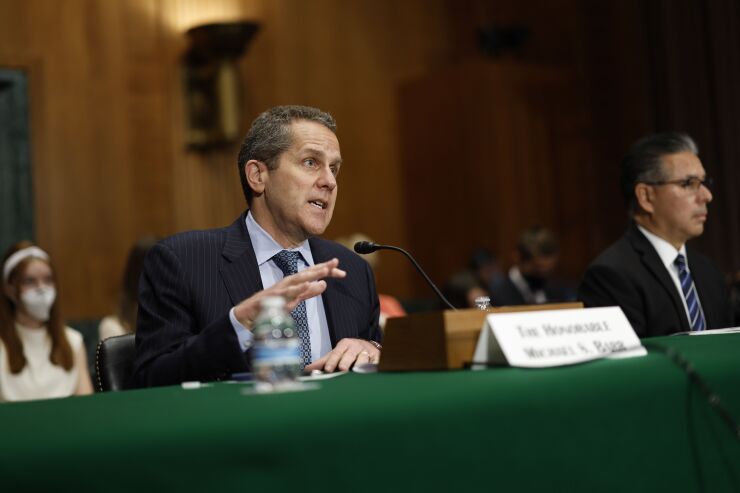Federal Reserve Gov. Michelle Bowman said the central bank should proceed with caution as it reconsiders various aspects of the bank capital framework, including stress testing, the countercyclical capital buffer, supplemental leverage ratio and other rules.
Speaking at the Institute for International Finance Friday morning, Bowman said her philosophy toward bank regulation centers around the core principle of balancing the need for prudential oversight and the need for that oversight to be deliberate, predictable and efficient.
"In the design of a regulatory framework, there is flexibility in how to achieve a desired outcome, and there are often multiple approaches that would be effective in doing so," Bowman said. "Once a decision has been made to regulate an activity, the next objective should be to ensure that the regulation achieves its intended purpose and that there are not more efficient alternatives that can yield those benefits at a lower cost."

Bowman noted that there was strong public support for infusing additional capital, liquidity and resolvability requirements into the banking system following the 2008 financial crisis, particularly for the largest banks, and said those changes have been successful in making the banking and financial systems more resilient to shocks. But there are also risks to the financial system that can emerge from overburdening the banking system with prudential rules when they serve marginal benefit to safety and soundness.
"There are obvious risks from under-regulation, and it is those risks that were addressed in the wake of the financial crisis 14 years ago," Bowman said. "[But] calibrating capital requirements is not a zero-sum game, where more capital is necessarily always better. Regulation is not cost-free. Over-regulation can restrain bank lending, which becomes a burden for individual borrowers and a potential threat to economic growth."
Bowman said the stress testing program — a centerpiece of the Fed's supervisory innovations after 2008 — has been effective in both tailoring burdens to a bank's risk profile and ensuring banks are resilient to shocks. But the tests as currently implemented can have the effect of forcing banks to make capital allocation choices that respond to the test's theoretical scenarios without a demonstrable resilience benefit.
"These year-to-year variations are often not based on underlying changes to banks' business models and can create short-term challenges for capital management," Bowman said. "There are likely many ways to limit this volatility while maintaining the value of the Board's stress tests, including by averaging results over multiple years."
Bowman likewise expressed skepticism about the efficacy of the countercyclical capital buffer, or CCyB — a rule designed to raise capital levels in good times to ensure lending continues through the business cycle. Bowman noted that the CCyB has never been raised, and given the banking system's resilience through the COVID pandemic, the Fed should carefully consider whether raising the buffer would actually confer a benefit.
"While having releasable capital buffers shouldn't necessarily be ruled out, in my view … we have seen that the existing level of capital requirements has proven to be adequate for banks to deal with significant stress," Bowman said. "Balancing safety and soundness with the need for appropriate risk-taking means that we should not simply assume that the further layering on of capital requirements, including through the application of the CCyB, would be beneficial."
Bowman's comments come in contrast to comments made by the Fed's newly-sworn-in vice chair for supervision, Michael Barr, who

Barr also said that he had concerns about the existing bank merger process, and said that allowing banks to merge without careful consideration could lead to "non-price" harms to consumers, including access to financial services.
Bowman, however, expressed concern about adopting a policy that limits M&A activity as a matter of course, noting during a question-and-answer session following her prepared remarks that banks' operating costs — particularly related to technology and compliance — are such that mergers make the most sense and could even further the Fed's goals of ensuring financial access in rural and disadvantaged communities.
"We've seen a great deal of consolidation over the past year — I expect that that's likely to continue as the expenses that are required to implement the technologies that consumers are interested in … I think those expenses are only going to continue to increase," Bowman said. "If we're not providing an environment where, if the outcome that a bank is interested in is to merge or become no longer in existence and sell themselves to someone else, that there's an opportunity to do that. Where we're limiting those opportunities, oftentimes, there is no succession planning for an institution in a rural market or an area that might not be attractive to an acquisition."
Bowman also said the Fed should consider expanding the kinds of supervisory materials that it makes public in the name of transparency and fairness. Specifically, the criteria that the Fed uses to examine banks subject to the Large Institution Supervision Coordinating Committee, or LISCC, should be made public, she said.
"Making these materials public would not only improve transparency, doing so would also provide some assurance to the banks subject to them that they are being held to the same supervisory expectations as their peers over time," Bowman said. "Without this clarity, it is far more challenging to build trust in this aspect of the supervisory process."





